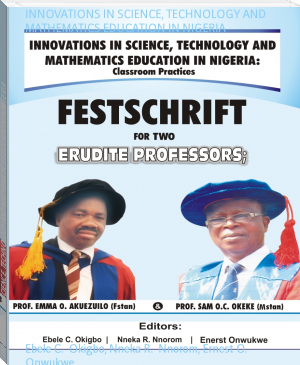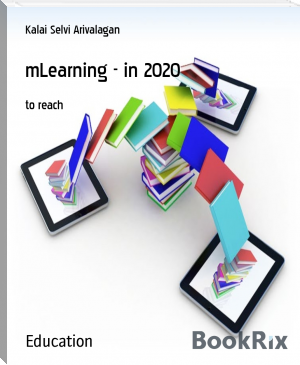INNOVATIONS IN SCIENCE, TECHNOLOGY AND MATHEMATICS EDUCATION IN NIGERIA, Ebele C. Okigbo, Nneka R. Nnorom, Ernest O. Onwukwe [best reads .TXT] 📗

- Author: Ebele C. Okigbo, Nneka R. Nnorom, Ernest O. Onwukwe
Book online «INNOVATIONS IN SCIENCE, TECHNOLOGY AND MATHEMATICS EDUCATION IN NIGERIA, Ebele C. Okigbo, Nneka R. Nnorom, Ernest O. Onwukwe [best reads .TXT] 📗». Author Ebele C. Okigbo, Nneka R. Nnorom, Ernest O. Onwukwe
Having identified the importance and difficulties encountered while solving quadratic equations, methods of improving students’ achievement in mathematics and quadratic equations in particular will be the key strategy to address the issue of poor achievement of students in mathematics. No wonder Riley, Luban, Holmes, Gore and Morgan (2017) emphasized that innovative teaching methods that provide positive mathematical learning experiences will enhance students’ achievement in mathematics. This means, mathematics teachers should show concern on the ways students should learn mathematics effectively with utmost interest and better achievement. Hence effort now is to use Activity – Based Learning in solving quadratic equations.
Activity -Based Learning is a pedagogical approach to teaching and learning where students explore subject by simulation, manipulation of tools and materials associated with the world of work. Ravı and Xaviera (2007) defined Activity- Based Learning as the desired learning activities in knowledge, attitude and skill. In Activity-based Learning, both the teachers and students engage in different learning activities like research based activity, practical investigations, problem solving activity, project work, class discussion, simulation, collaborative, field trips, project, debate, demonstration, dramatization, questioning and role-playing. In the process of these activities, students think in original ways, find practical solutions and have self-esteem in the developmental period of learning
Study on the Activity-Based Learning (ABL) supported the cognitive-learning theory of some constructivists Psychologists like Dewey, Piaget, and Vygotsky. These Psychologists advocated that students that engage in ABL are active rather than passive recipients of information. They further believed that individuals should construct knowledge and learning processes based on previous experience. Finding of Hussain, Anwar and Majoka (2011) showed that ABL is more effective in teaching Physics at secondary level as compared to traditional method of teaching. Result of the study conducted by Gurbuz, Catlioglu, Birgin and Erdem (2010) showed that ABL affected the teaching of probability concepts positively. Finding by Douglas and Joke (2016) showed that ABL pedagogy played an essential role in increasing teachers’ experiences and integrating technology into teaching activities.
The result of the study conducted by Blake, Hosokawa and Riley (2000) showed that students that were taught through ABL performed significantly better in both basic and clinical sciences. Similarly, the finding by Polanco, Calderon and Delgado (2004) showed that ABL students performed significantly better than traditional students in mechanic with higher order thinking skills. However, some of the findings in ABL showed contrary result. For instance, finding by Bassett, Martinez, and Martin (2014) showed that the success rate of the students in the classroom with teacher-guided education was higher than those in the Activity- Based Learning (ABL) classroom. Colliver (2000) could not find any evidence to maintain the superiority of ABL over traditional method of teaching. The findings of Hung, Jonassen, and Liu (2008) showed that students taught with traditional method retained more than ABL students in the recall test conducted immediately. Zumbach, Kumpf and Koch (2004) found no significant difference in knowledge acquisition between students who learned through ABL and those who learned through traditional method.
The studies reviewed on ABL did not identify a single direction of mathematics achievement of gender (male and female students) as a moderating variable despite strong indication by Kadiri, (2004) that gender is a strong predictor of students’ achievement in mathematics. However, Igbo, Onu and Obiyo (2015) regarded gender as how individuals perceive themselves in such a way that most people of the same sex identify themselves with certain attributes. Literatures reviewed have shown that most studies conducted in ABL were in Physics, probability, basic science, clinical science and mechanics. Few studies conducted in mathematics did not investigate the effect of ABL on students’ achievement in quadratic equations despite the fact that questions in quadratic equations come out in both internal and external examinations at the senior secondary school level. Therefore this study investigated the effect of ABL on achievement in quadratic equations among the senior secondary students in Onitsha North Local Government Area of Anambra State.
Purpose of the Study
The purpose of the study was to determine the effect of Activity- Based Learning on students’ achievement in quadratic equations. The study specifically determined the:
Mean achievement scores of mathematics students’ taught quadratic equations with Activity – Based Learning (ABL) and those taught with conventional method.
Mean achievement scores of male and female students taught quadratic equations using ABL.
Scope of the Study
The study was restricted to the effect of Activity- Based Learning on students’ achievement in quadratic equations in Onitsha North Local Government of Anambra State. The content areas of quadratic equations covered included factorization method, completing the square method, quadratic formula method and graphical method.
Research Questions
The following research questions guided this study.
What are the mean achievement scores of mathematics students taught quadratic equations with ABL and those taught with conventional method?
What are the mean achievement scores of male and female students taught quadratic equations using ABL?
Hypotheses
The following null hypotheses will be tested at 0.05 alpha level.
Ho1: There is no significant difference between the mean achievement scores of students taught quadratic equations using ABL and those taught with conventional method.
Ho2: There is no significant difference between the mean achievement scores of male and female students taught quadratic equations using ABL.
Method
This study determined the effect of Activity- Based Learning (ABL) on students’ achievement in quadratic equations. The study was carried out on the effect of ABL on SSII students’ achievement in quadratic equations in Onitsha North Local Government area of Anambra State. The study employed pre-test post-test quasi experimental research design. Two research questions and two hypotheses tested at 0.05 alpha level guided the study. The population of the study consisted of 1603 Senior Secondary two (SSII) students in Onitsha North Local Government of Anambra State. A sample of 177 SSII students randomly selected from four intact classes was used. The treatment group consisted of 93 students while the control group were 84 students.
The instrument for data collection was Quadratic Equations Achievement Test (QEAT) which contained 25 multiple choice items (five (5) of knowledge, five (5) of comprehension, five (5) of application, five (5) of analysis and five (5) of synthesis levels). The instrument was face and content validated by three experts. The corrections and suggestions made were incorporated in the final draft of the test items. Reliability of the instrument was estimated at 0.71 and 0.89 using split-half reliability method.
The experiment was conducted during the normal school periods following the school timetable which lasted for 4 weeks. The class mathematics teacher who was trained by the researchers used the researchers’ prepared eight lesson notes in factorization method, completing the square method, quadratic formula method and graphical method for teaching the control and experimental groups. The lesson note on ABL in quadratic equations was used for treatment group whereas lesson note on conventional method was used for the control group. Before the experiment, subjects in the treatment and control groups were given the pre-test. At the end of the experiment, the researchers with the help of the class mathematics teacher administered the post-test to the subjects in the two groups. The pre-test and post-test were the same except that the colour of the print was changed from black to blue and the item numbers were reshuffled. The scripts were marked and recorded using the same marking guide. Data were analyzed using mean, standard deviation and t- test.
Result
Research Questions 1: What are the mean achievement scores of mathematics students taught quadratic equations with ABL and those taught with conventional method?
Table 1: Mean ratings and standard deviation of mathematics students taught quadratic equations with Activity – Based Learning and those taught with conventional method.
Pre-test Post-test
Group N Mean SD Mean SD Mean gain
Experimental 93 48.41 11.23 69.78 9.94 21.37
Control 84 48.35 11.14 55.49 10.95 6.14
Table 1 shows that the students taught quadratic equations with Activity – Based Learning had a higher mean score of 69.78 with mean gain of 21.37 as against students taught with conventional method who had mean score of 55.49 with mean gain of 6.14. This, shows that ABL is more effective than conventional method in teaching quadratic equations.
Research Question 2: What are the mean achievement scores of male and female students taught quadratic equations using ABL
Table 2: Mean ratings and standard deviation scores of male and female students taught quadratic equations using the Activity- Based Learning
Pre-test Post-test .
Group N Mean SD Mean SD Mean gain
Male 38 43.48 9.47 53.18 9.63 9.70
Female 55 47.08 7.63 65.18 8.47 18.10
Table 2 shows that the male students taught quadratic equations with ABL had the mean score of 53.18 with mean gain of 9.70 while the female students taught with Activity – Based Learning had the mean score of 65.18 with mean gain of 18.10. This shows that both male and female students taught achieve high in quadratic equations with the use of ABL, although the mean scores of females are higher than their male counterparts.
Hypothesis 1: There is no significant difference between the mean achievement scores of students taught quadratic equations using Activity – Based Learning and those taught with conventional method.
Table 3: t-Test difference in the mean achievement scores of students taught quadratic equations using Activity – Based Learning and those taught with conventional method.
Group N X SD df α t-crit t– cal Decision
Experimental 93 69.48 9.94
75 0.05 1.96 9.04 Reject Ho
Control 84 55.49 10.95
The result in Table 3 shows that t- crit value of 1.96 is less than the t-cal value o f 9.04 at 0.05 level of significance. Therefore, the null hypothesis is rejected. This means, there is a statistically significant difference the mean achievement scores of students taught quadratic equations using ABL and those taught with conventional method. Based on the result, students taught with ABL achieve better that those taught with conventional method.
Hypothesis 2: There is no statistically significant difference between the mean achievement score of male and female students taught quadratic equations using activity – based learning.
Table 4: t-Test difference in the mean achievement scores of male and female students taught quadratic equations using ABL.
Group N X SD df α t-crit t– cal Decision
Male students 38 53.18 9.63
91 0.05 1.96 -1.0 Ho Upheld
Female students 55 65.18 8.47
The result in Table 4 shows that t- crit value of 1.96 is greater than t-cal value of -1.0 at 0.05 level of significance. Therefore, the null hypothesis is upheld. This means, there is no statistically significant difference between the mean achievement scores of male and female students taught quadratic equations using ABL. Both male and female students performed equally well when exposed to the ABL.
Discussion
The results from this study indicated that students taught quadratic equations with ABL performed better than students taught with conventional method. The finding of this study is in agreement with the result of Khan, Muhammad, Ahmed, Saeed and Aman (2012), which showed that ABL significantly improved students' academic performance than the traditional method. The findings of this study is in agreement with the earlier study of Polanco, Calderon & Delgado (2004) which showed that activity –based learning students performed significantly better than traditional students in mechanic with higher order thinking skills. This finding is consistent with the statement made by Gürbüz, Çatlıoğlu, Birgin and Erdem (2010) that usage of activities in learning environments put the students into the centre, provide richer learning opportunities, make mathematics teaching fun and encourage students to study mathematics.
The finding of this study showed that there is a statistically significant difference between the mean achievement scores of students taught quadratic equations with activity – based learning and





Comments (0)